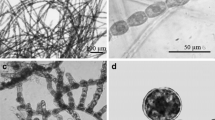Abstract
Encystment, which at a temperature of 15°C is photoperiodically controlled inGonyaulax polyedra, can also be induced by a decrease of temperature, from 20 to 10 or 8°C in the absence of photoperiodic signals. The cyst-inducing capacity of the decrease in temperature depends on the circadian phase: in constant light, the maximum of sensitivity was found at the beginning of subjective night. In a light/dark cycle, however, cyst formation was reduced during dark phase, indicating that light is required for the process of encystment. A similar light dependence was seen in the effect of the physiologically occurring cyst inducer 5-methoxytryptamine, but not in the encystment response to the protonophores monensin and nigericin.
Similar content being viewed by others
References
Balzer, I., and Hardeland, R. Science253 (1991) 795.
Balzer, I., and Hardeland, R., Chronobiol. Int.9 (1992) 260.
Hardeland, R., and Balzer, I., in: Trends in Comparative Biochemistry and Physiology, vol. 1, p. 71. Ed. J. Menon. Research Trends. Trivandrum 1993.
Pöggeler, B., Balzer, I., Hardeland, R., and Lerchl, A., Naturwissenschaften78 (1991) 268.
Balzer, I., Pöggeler, B., and Hardeland, R., in: Melatonin and the Pineal Gland — From Basic Science to Clinical Application. p. 183. Eds Y. Touitou, J. Arendt and P. Pévet. Excerpta medica, Amsterdam 1993.
Hardeland, R., Experientia49 (1993) 614.
Hoffmann, B., and Hardeland, R., Comp. Biochem. Physiol.81C (1985) 39.
Hardeland, R., Comp. Biochem. Physiol.66C (1980) 53.
Njus, D., McMurry, L., and Hastings, J. W., J. comp. Physiol.117 (1977) 335.
Thorey, I., Rode, I., Harnau, G., and Hardeland, R., J. comp. Physiol.157 B (1987) 85.
Balzer, I., and Hardeland, R., Int. J. Biomet.32 (1988) 231.
Hardeland, R. Behrmann, G., and Balzer, I., Abstr. IXth A. Meet. Eur. Soc. Chronobiol., Bath 1993, abstr. no. 14.
Balzer, I., and Hardeland, R., in: Chronobiology and Chronomedicine, p. 127. Eds C. Gutenbrunner, G. Hildebrandt and R. Moog. Lang, Frankfurt/M. 1993.
Behrmann, G., Doctoral thesis, Göttingen 1993.
Author information
Authors and Affiliations
Rights and permissions
About this article
Cite this article
Hardeland, R. Induction of cyst formation by low temperature in the dinoflagellateGonyaulax polyedra Stein: Dependence on circadian phase and requirement of light. Experientia 50 (Suppl 1), 60–62 (1994). https://doi.org/10.1007/BF01992051
Received:
Accepted:
Issue Date:
DOI: https://doi.org/10.1007/BF01992051




